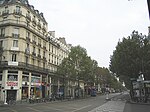Rue Saint-Denis (Paris)
Red-light districts in FranceRoman ParisStreets in the 1st arrondissement of ParisStreets in the 2nd arrondissement of Paris

Rue Saint-Denis is one of the oldest streets in Paris. Its route was first laid out in the 1st century by the Romans, and then extended to the north in the Middle Ages. From the Middle Ages to the present day, the street has been notorious as a place of prostitution. Its name derives from it being the historic route to Saint-Denis. The street extends as far as the 1st arrondissement and Rue de Rivoli to the south and as far as the 2nd arrondissement and the boulevard Saint-Denis to the north. It runs parallel to the boulevard de Sébastopol.
Excerpt from the Wikipedia article Rue Saint-Denis (Paris) (License: CC BY-SA 3.0, Authors, Images).Rue Saint-Denis (Paris)
Rue Saint-Denis, Paris 2nd Arrondissement (Paris)
Geographical coordinates (GPS) Address Nearby Places Show on map
Geographical coordinates (GPS)
| Latitude | Longitude |
|---|---|
| N 48.864166666667 ° | E 2.35 ° |
Address
Rue Saint-Denis 137
75002 Paris, 2nd Arrondissement (Paris)
Ile-de-France, France
Open on Google Maps








